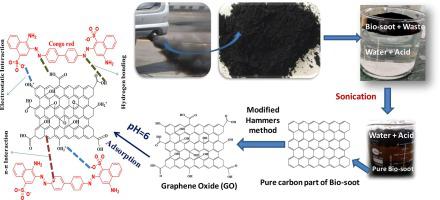Our official English website, www.x-mol.net, welcomes your feedback! (Note: you will need to create a separate account there.)
Preparation of Graphene Oxide from Bio-soot wastes: As an efficient adsorbent for highly noxious Congo red dye
FlatChem ( IF 6.2 ) Pub Date : 2020-11-01 , DOI: 10.1016/j.flatc.2020.100198 Shraban Kumar Sahoo , Jitendra Kumar Sahoo , Gagan Kumar Panigrahi , Dillip Kumar Pattanayak , Aninda Sundar Rout , Animesh Lenka
FlatChem ( IF 6.2 ) Pub Date : 2020-11-01 , DOI: 10.1016/j.flatc.2020.100198 Shraban Kumar Sahoo , Jitendra Kumar Sahoo , Gagan Kumar Panigrahi , Dillip Kumar Pattanayak , Aninda Sundar Rout , Animesh Lenka

|
Abstract In this study, the morphological structure of Bio-soot obtained from diesel engine was first investigated. It is observed that Bio-soot has a higher level of graphitization than Carbon Black or activated charcoal. Graphene oxide was prepared by oxidizing the Bio-soot powder using modified Hummer’s method. The prepared graphene oxide was characterized by using X-ray diffractometer (XRD), Fourier transformation infrared (FTIR), Raman, Brunauer-Emmett-Teller (BET), Field emission scanning electron microscopy (FESEM) and High resolution transmission electron microscopy (HRTEM) analytical techniques. The prepared graphene oxide was used as adsorbent for decontamination of highly toxic Congo red from aqueous media. The adsorption studies were carried out using UV–visible Spectroscopy while changing the different parameters such as adsorbent dosages, pH of the solution, contact time and initial concentration. The obtained adsorption results were fitted with kinetic and isotherm models and was concluded that adsorption of Congo red follows second order kinetic and Langmuir isotherm models with maximum adsorption capacities of 120.20 mg/g. This reflects the significance of graphene oxide over Bio-soot which owes due to increase of the adsorption sites after introducing oxygen containing groups on Bio-soot surface. Thermodynamic studies revealed that Congo red adsorption on graphene oxide surface is spontaneous and endothermic in nature.
中文翻译:

从生物烟灰废物中制备氧化石墨烯:作为高毒刚果红染料的有效吸附剂
摘要 本研究首次对柴油机生物炭黑的形态结构进行了研究。据观察,生物烟灰具有比炭黑或活性炭更高的石墨化水平。通过使用改进的 Hummer 方法氧化生物烟灰粉末制备氧化石墨烯。通过使用 X 射线衍射仪 (XRD)、傅里叶变换红外 (FTIR)、拉曼、Brunauer-Emmett-Teller (BET)、场发射扫描电子显微镜 (FESEM) 和高分辨率透射电子显微镜 (HRTEM) 对制备的氧化石墨烯进行表征) 分析技术。制备的氧化石墨烯用作吸附剂,用于去除水性介质中剧毒的刚果红。使用紫外-可见光谱法进行吸附研究,同时改变不同的参数,如吸附剂剂量、溶液的 pH 值、接触时间和初始浓度。所得吸附结果与动力学和等温线模型拟合,得出结论:刚果红的吸附遵循二级动力学和朗缪尔等温线模型,最大吸附容量为 120.20 mg/g。这反映了氧化石墨烯相对于 Bio-soot 的重要性,这是由于在 Bio-soot 表面引入含氧基团后吸附位点的增加。热力学研究表明,刚果红在氧化石墨烯表面的吸附是自发吸热的。所得吸附结果与动力学和等温线模型拟合,得出结论:刚果红的吸附遵循二级动力学和朗缪尔等温线模型,最大吸附容量为 120.20 mg/g。这反映了氧化石墨烯相对于 Bio-soot 的重要性,这是由于在 Bio-soot 表面引入含氧基团后吸附位点的增加。热力学研究表明,刚果红在氧化石墨烯表面的吸附是自发吸热的。所得吸附结果与动力学和等温线模型拟合,得出结论:刚果红的吸附遵循二级动力学和朗缪尔等温线模型,最大吸附容量为 120.20 mg/g。这反映了氧化石墨烯相对于 Bio-soot 的重要性,这是由于在 Bio-soot 表面引入含氧基团后吸附位点的增加。热力学研究表明,刚果红在氧化石墨烯表面的吸附是自发吸热的。这反映了氧化石墨烯相对于 Bio-soot 的重要性,这是由于在 Bio-soot 表面引入含氧基团后吸附位点的增加。热力学研究表明,刚果红在氧化石墨烯表面的吸附是自发吸热的。这反映了氧化石墨烯相对于 Bio-soot 的重要性,这是由于在 Bio-soot 表面引入含氧基团后吸附位点的增加。热力学研究表明,刚果红在氧化石墨烯表面的吸附是自发吸热的。
更新日期:2020-11-01
中文翻译:

从生物烟灰废物中制备氧化石墨烯:作为高毒刚果红染料的有效吸附剂
摘要 本研究首次对柴油机生物炭黑的形态结构进行了研究。据观察,生物烟灰具有比炭黑或活性炭更高的石墨化水平。通过使用改进的 Hummer 方法氧化生物烟灰粉末制备氧化石墨烯。通过使用 X 射线衍射仪 (XRD)、傅里叶变换红外 (FTIR)、拉曼、Brunauer-Emmett-Teller (BET)、场发射扫描电子显微镜 (FESEM) 和高分辨率透射电子显微镜 (HRTEM) 对制备的氧化石墨烯进行表征) 分析技术。制备的氧化石墨烯用作吸附剂,用于去除水性介质中剧毒的刚果红。使用紫外-可见光谱法进行吸附研究,同时改变不同的参数,如吸附剂剂量、溶液的 pH 值、接触时间和初始浓度。所得吸附结果与动力学和等温线模型拟合,得出结论:刚果红的吸附遵循二级动力学和朗缪尔等温线模型,最大吸附容量为 120.20 mg/g。这反映了氧化石墨烯相对于 Bio-soot 的重要性,这是由于在 Bio-soot 表面引入含氧基团后吸附位点的增加。热力学研究表明,刚果红在氧化石墨烯表面的吸附是自发吸热的。所得吸附结果与动力学和等温线模型拟合,得出结论:刚果红的吸附遵循二级动力学和朗缪尔等温线模型,最大吸附容量为 120.20 mg/g。这反映了氧化石墨烯相对于 Bio-soot 的重要性,这是由于在 Bio-soot 表面引入含氧基团后吸附位点的增加。热力学研究表明,刚果红在氧化石墨烯表面的吸附是自发吸热的。所得吸附结果与动力学和等温线模型拟合,得出结论:刚果红的吸附遵循二级动力学和朗缪尔等温线模型,最大吸附容量为 120.20 mg/g。这反映了氧化石墨烯相对于 Bio-soot 的重要性,这是由于在 Bio-soot 表面引入含氧基团后吸附位点的增加。热力学研究表明,刚果红在氧化石墨烯表面的吸附是自发吸热的。这反映了氧化石墨烯相对于 Bio-soot 的重要性,这是由于在 Bio-soot 表面引入含氧基团后吸附位点的增加。热力学研究表明,刚果红在氧化石墨烯表面的吸附是自发吸热的。这反映了氧化石墨烯相对于 Bio-soot 的重要性,这是由于在 Bio-soot 表面引入含氧基团后吸附位点的增加。热力学研究表明,刚果红在氧化石墨烯表面的吸附是自发吸热的。



























 京公网安备 11010802027423号
京公网安备 11010802027423号